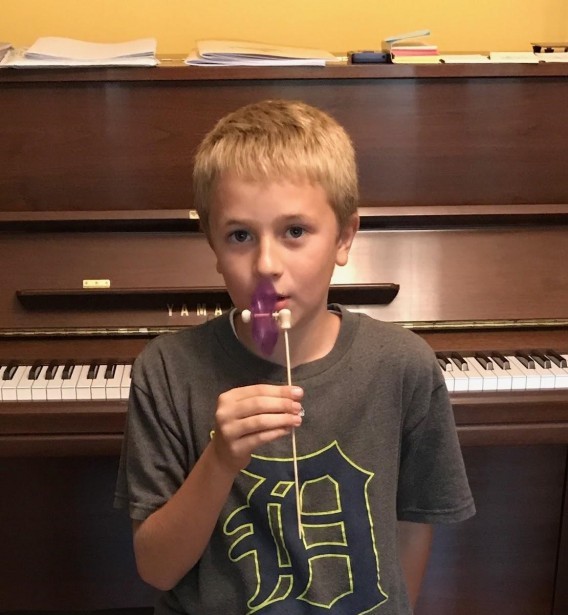Breath: Teaching piano students how to utilize a vital tool

Breathing is the only function of the autonomic nervous system that can happen both consciously and unconsciously. Research has shown the many benefits of practicing controlled breathing techniques such as stress relief and improved functioning of the immune system.1 When applied in a pedagogical setting, teaching controlled breathing techniques and practicing mindful breathing may give piano students of all ages a powerful tool to help calm performance anxiety and find greater enjoyment in their music making. Introducing breath awareness exercises into the piano lesson may thus be an immense opportunity for teaching students how to harness and focus their energy, develop self-efficacy and discover tools for focusing the mind.
Mechanically, breathing consists of an inhalation and an exhalation. When done unconsciously, this process occurs under metabolic control via signals from the respiratory center in the brainstem. An alternative to metabolic control of the breath, however, is behavioral control, which is defined as any voluntary control of the breath.2 This voluntary control can be as simple as taking a few deep breaths to calm nerves, or it can consist of more extended breathing patterns and techniques. Research has indicated that practicing these various kinds of controlled breathing can improve physical and mental wellbeing by combatting stress, anxiety and depression.3 Beyond the scientific community, mainstream media has embraced this notion; National Public Radio published a piece in 2010 on breathing as the body’s “built in stress reliever,”4 and more recently, in 2016, The New York Times published an article enumerating the benefits of controlled breathing.5
Yogic breathing is one tradition that practices harnessing the healing potential of the breath. In yoga, breath control is referred to as pranayama, which literally translates to “control of life force.” There are many different kinds of pranayama in which breathing varies by duration and parts of anatomy utilized and focused upon.6 Yoga has thus been used as the method for a number of studies on how breathing positively affects health.7,8,9
But what exactly is to be gained from teaching breathing techniques in piano lessons? One of the primary benefits of practicing breathing techniques in the context of piano playing may be managing performance anxiety. When we are nervous—in the pianist’s case preceding, during, or even after a performance—we tend to breathe using the upper chest more than the diaphragm, which results in a shallower breath.10 Performance anxiety can cause symptoms such as increased heart rate, breathlessness, muscular tension, trembling, sweaty palms, and racing thoughts.11 These symptoms are produced by the sympathetic part of the autonomic nervous system. Controlled breathing can activate the parasympathetic nervous system to reverse these effects. Studies have examined children both with and without diagnosed anxiety disorders and shown that practicing yoga breaths may decrease anxiety in both populations.12 As pianists advance on their instrument, yogic breathing may well continue to benefit them; yoga and meditation have also been evidenced as beneficial to young professional musicians in terms of reducing performance anxiety and improving mood.13
Besides reducing stress, another goal of yogic breathing is to increase awareness of and attention to cognitive and physical functioning.14 Study of the effects of yoga practice to children has also indicated improved concentration, focus, and spatial memory, which may benefit piano playing.15
Incorporating breathing techniques into the piano lesson need not take too much time and one does not need to be a highly-trained master to be able to do so! The fundamental components of incorporating breathing are the willingness to pause, bring attention to the present moment and pay attention to the breath. The following is a list of simple breathing exercises that may be incorporated into piano lessons to help students enjoy the benefits of deep and controlled breathing for their practice and performance.

Exercise 1: Calming breath
Transitioning into the piano lesson can often feel hasty, especially with shorter lessons when much needs to be accomplished in a short period of time. The student often comes to her lesson after a long day at school, or after a series of afternoon activities. The teacher likely has multiple lessons scheduled in one afternoon and keeps an eye on the clock to ensure timely beginnings and endings of lessons. Taking thirty seconds to reset concentration before each lesson benefits both the student and the teacher. Here is a simple activity that combines both a muscle warm-up and a focused breath:
- Sit on the bench and feel your feet on the ground and your weight transferring to the bench.
- Drop your arms to your sides (see Figure 1).
- Inhale while lifting your arms overhead, reaching out with your fingertips and releasing your shoulders down and back.
- At the top of the inhalation your arms should be overhead, reaching towards the ceiling (see Figure 2).
- Slowly exhale, while returning your arms down to your sides.
- Repeat this breath three times.

Exercise 2: Energizing breath
At other times the student may come to her lesson feeling lethargic and tired. During these times, having tools to energize her can turn a potentially unproductive lesson to a fun and engaging one!
- Start by finding your best sitting position on the bench with your arms on your lap.
- Pretend that you are a dog who was just out playing and is panting. With your mouth open pant like a dog through the mouth.
- Then close your mouth and continue panting through the nose.
Exercise 3: Pre-performance concentration breath
Right before a performance the physical experience can feel foreign to a student unaccustomed to performing in public. The sensations of the heart racing, the mind jumping from thought to thought, and the self-doubt that can suddenly emerge are enough to trigger fear and anxiety. Preparing the student for these sensations and practicing a breathing technique that can help concentration and bring about a sense of calm can do wonders in terms of triggering the relaxation response in the body. For this particular breath, you can use a prop such as a toy windmill. The prop helps focus the mind by giving it an external object to look at and focus on. This may be helpful as there is so much turmoil happening internally.

- Hold the windmill with one hand about six inches in front of the mouth (see Figure 3).
- Inhale deeply and gently blow towards the windmill. The objective is to control the exhalation to where the windmill is spinning steadily and for as long as possible.
- Repeat the breath cycle five times.
- Take a break and repeat as many times as needed until the breath feels slower and the mind more focused.
By teaching and practicing simple breathing exercises such as these, we may equip our students with a powerful tool to address performance anxiety. Students may also find that mindful breathing helps them gain greater awareness of their body during practice and performance, and improves their mood and energy. Incorporating such mindful breathing techniques is accessible to all and can easily be incorporated into your lessons starting today!
Notes
1R. P. Brown & P. L. Gerbarg (2005), “Sudarshan Kriya Yoga Breathing in the Treatment of Stress, Anxiety, and Depression: Part II—Clinical Applications and Guidelines,” The Journal of Alternative and Complementary Medicine 11(4): 711-717.
2S. Novotny & L. Kravitz (2017), “The Science of Breathing,” University of Minnesota, https://goo.gl/bKCGFV.
3Brown, 712.
4G. Cuda (6 Dec. 2010), “Just Breathe: Body Has a Built-In Stress Reliever,” NPR.
5L. Alderman (9 Nov. 2016), “Breathe. Exhale. Repeat: The Benefits of Controlled Breathing,” The New York Times.
6Novotny & Kravitz.
7Brown, 715.
8L. S. White (2009), “Yoga for Children,” Pediatric Nursing 35(5): 277-295.
9M. L. Galantino, R. Galbavy, & L. Quinn (2008), “Therapeutic Effects of Yoga for Children: A Systematic Review of the Literature,” Pediatric Physical Therapy: 66-80.
10P. Roskell (2000), “Balancing Act,” Piano: 33-35.
11“Performance Anxiety,” The Medical Dictionary.
12Galantino, 70.
13S. B. S. Khalsa, S. M. Shorter, S. Cope, G. Wyshak, & E. Sklar (2009), “Yoga Ameliorates Performance Anxiety and Mood Disturbance in Young Professional Musicians,” Appl Psychophysiol Biofeedback 34: 279-289.
14Novotny.
15Galantino, 71.
By Paola Savvidou and Haley Myers. This article first appeared on www.ClavierCompanion.com.





